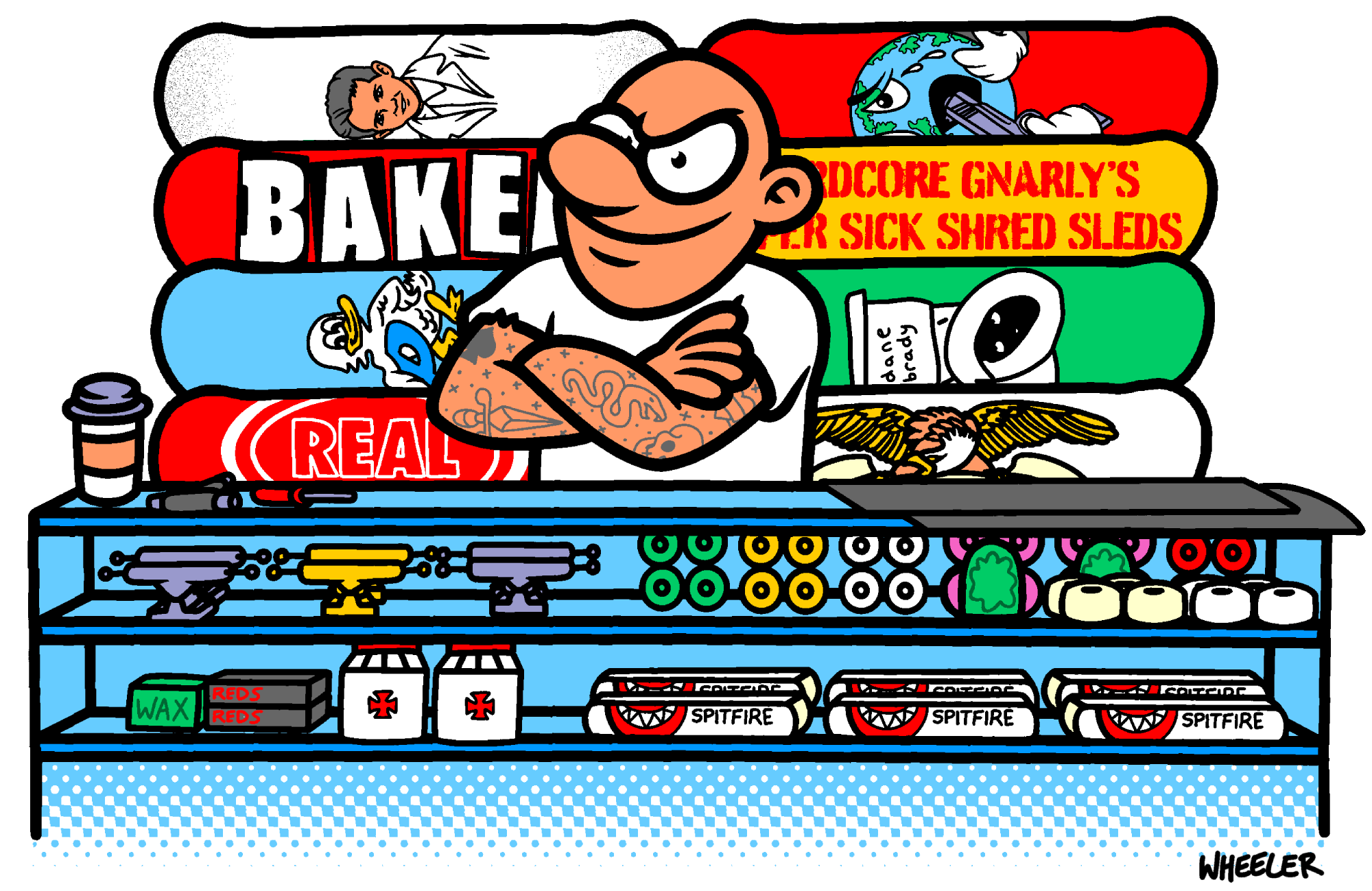
Skateboarding is getting more popular than ever, so to help ease people into our wonderful world, we wanted to give out some advice for beginners so they can buy exactly what they need and not look like a sucker in the process.
It can be confusing knowing where to start, and skate shops can be intimidating—the guy behind the counter may or may not even work there, and the walls and shelves are filled with heaps of options to choose from.
First things first, you should try and find a local skate shop in your area, something small and owned by skaters. It’s important to support local shops as much as possible to keep what’s cool about skateboarding alive like fun events, and just being a place to hang out for kids with nowhere else to go, so you want your money to go straight to them. If you don’t have one close by, check out Parade World, an online marketplace where reputable skate shops sell their goods.
Once you figure out where you’re going to buy your new setup, you need to know what it is exactly you want to buy. Let’s break it down piece-by-piece and give you the dummy’s guide to all the different components.

DECKS
The deck is the “board” part of the skateboard, so you can probably guess that it’s one of the most important parts of a skateboard. It makes direct contact with your feet and is the most flashy part of any setup, so it’s a fun chore to choose one. There are all sorts of deck shapes, sizes, colors, and price points to pick from, but there are some basic guidelines a good deck will have:
Most boards are made of seven plies of maple wood glued and pressed together, with a heat-transferred or screen printed graphic on the bottom, and should range from $40-$70 in the continental USA. Pick the design based on your preference, from My Little Pony to a board shaped like a vibrator. It doesn’t really matter because eventually you should be scratching that sucker up with some grinds and slides in no time. The main thing you might need some help navigating is the different sizes.
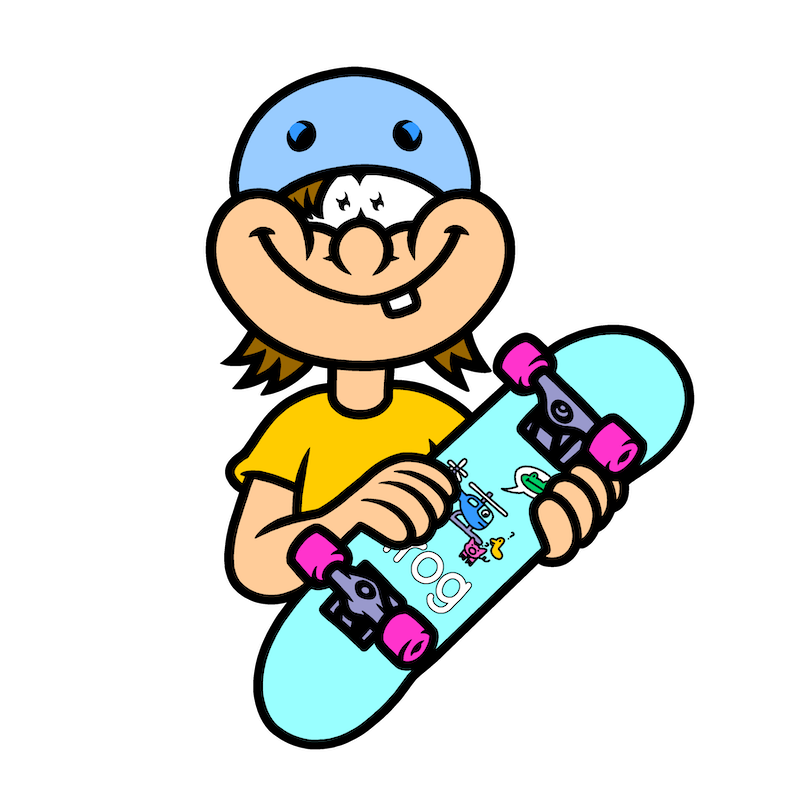
The Teeny Bopper Deck
If you’re buying this board for a kid or for someone with shorter legs than the average adult, you’re also going to want to size your board down proportionately. We aren’t saying to go out and buy a plastic Penny board (please no), but something in the 7.5” – 8” width and less than 32” length should serve you well. Not many brands make smaller boards than this, but that’s fine, as anyone from young kids to OG pros from the early-90s have been known to ride these sizes.

The “Do It All” Deck
If you’re an average teen or adult looking to get into skateboarding to do street and/or skate park skating, then you will probably want a board that falls within the 8.12” to 8.38” range. If you’re an overall smaller human, you should lean toward the smaller end of the scale, and vice versa. As a reference, a size 9 men’s shoe will feel right at home on any deck in this range.
Most boards of this width will feel comfortable lengthwise, so until you get more nuanced with your trick selection and style of skateboarding, you don’t have to get too nitpicky about this.

The “Transition/Pool” Deck
If you’re primarily looking for a board that will help you keep your skating low to the ground, this will be your best bet. Boards 8.5” and above will give you all the width you’ll need in order to control your board in tight turns and transitions in the park without having your toes or heels drag, which would send you plummeting to the flat bottom of a ramp or right into the ground at full speed.
One caveat though: the bigger the board the more force it takes to ollie and flip it. So if you do want to do some eventual tech skating, keep that in mind. But if you’re not too concerned about busting a clean switch flip and just want a comfy, chill ride, this is the move for you.
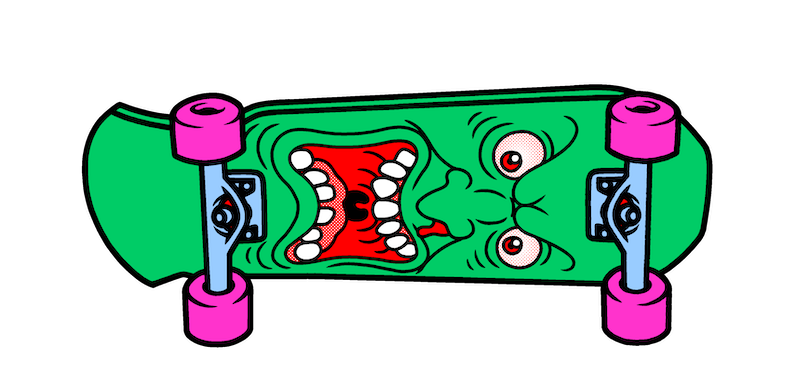
The “Retro Inspired” Deck
While the popsicle-stick shape has been en vogue for a couple of decades now, skateboards used to come in all sorts of funky silhouettes, and some of them are starting to look that way again. A lot of shaped boards sacrifice versatility for novelty, so if you want a board that looks like a stack of Oreos, Gumby, or Marisa Tomei, boy, do we have a brand for you! Other brands, like Welcome, offer shapes that even a new skater can find function with.
There’s not a whole lot of guidance here as far as what the “right” choice would be for a beginner, as these decks are mainly based on aesthetic choices with their unique shapes and graphics. Just use a little logic (if there’s no nose, it’s way harder to do nose manuals, etc…) and go for one that you think looks/feels cool.

GRIPTAPE
This bit is the subject of many stupid debates within the skateboarding community, but, truth be told, the product is pretty much the same: sticky tape with a grippy surface.
More likely than not, your board will come with a free sheet of griptape if you buy it in a skate shop, or you might have to pay about $5 for a sheet. The two most common brands are Mob and Jessup, which have a few key differences. The consensus is that Mob is more grippy (too abrasive according to some), while Jessup is more “broken-in.” Mob is also perforated to make it easier to apply without getting air bubbles. However, real skaters know you can just use a razor to poke through any air bubbles a Jessup sheet might get.
There are also a bunch of other brands out there that offer unique graphics on their griptape, like Shake Junt, Grizzly, and Diamond. But we’ll just say that most pros stick with basic black griptape unless that company is paying them to do so.
Finally, there’s lots of different ways you can apply it to your deck. Check out this guide of a few tried-and-true techniques for hints.

TRUCKS
Now you need the metal bits that attach to your freshly-gripped deck. For a newbie, and even for a veteran, all the different heights and sizes of trucks on offer can be a bit much, but the difference between a quarter-inch here matters a little, so it can only help to know what you’re looking for.
Wide or Narrow?
The biggest concern will be getting the right width truck for the deck you buy. Anything too small and you won’t be getting the correct amount of turning power for your setup and you’ll suffer from wheel bite. Anything too big and your axles will be jutting out of the side of your deck and you can even accidentally step on your wheel and get sent flying face first.
One of the biggest nuisances when it comes to trucks is that there doesn’t seem to be any universal sizing across the industry, and their product names are often no help. Check out the sizing guides for whatever truck brand that catches your eye, and match it up to the size best suited for your deck’s width.
For example, an 8.38” board will match up pretty closely with a pair of Independent or Thunder 149 width trucks, while a 8.25” would be better on 139s.

High or Low?
Next, you’ll want to choose whether you want your trucks Low or High.
High trucks mean more space for your wheels to turn without biting the board, which is especially helpful when you’re starting out. High trucks also mean you can get bigger wheels (we’ll get to those in a bit). The cons are that they’ll be just a wee bit heavier and might make it a little harder to learn to pop your board because you’ll have to give more force to make the tail hit the ground.
If you are set on getting tech because you still think Rodney Mullen is the greatest skater of all time, you might want to get some Lows, which will make it easier to pop and flick due to the lower center of gravity.
Of course, you’ll hit a ceiling with how big your wheels can be (usually max out at around 53mm), and you might not be able to rock soft wheels because those are usually bigger, but Lows are a good choice for the low-impact newbie.
Fancy Materials and Paint Jobs
Trucks come in all kinds of metals and paint jobs, but plain ol’ forged steel options are the standard.
Graphics and colors will have absolutely no effect on the trucks’ overall performance and are purely for aesthetic purposes. If you find a graphic or color that will compliment your graphic or that you simply think looks cool, go for it. Do you!

WHEELS
Without the wheels you wouldn’t get far in your blossoming skate career, so you’re going to want to grab a set of those next. Typical skate wheels meant for street and park use come in all sorts of shapes, sizes, and colors. These differences matter a bit more than they do with the deck, with the main factor you should worry about being the wheel’s hardness.
Just Hard Enough
Harder wheels (101a) will slide more easily, which may sound like a bad thing, but might actually be a lifesaver when learning tricks. That little bit of slide can be the difference between rolling away cleanly from a trick or being sent straight to the ground from a sketchy landing. Harder wheels will also be easier powerslide with, which can open up a lot of fun down the line, especially when bombing hills or when you need to narrowly avoid crashing into a scooter kid in the skatepark.
Softer wheels (99a) are not really all that much softer, but they will be harder to initiate slides with, although not entirely impossible as with gummier wheels of a lower durometer number (80b, etc). The bottom line on hardness: the lower the number, the smoother the ride, but also the more difficult it’ll be to slide, meaning they’re more potentially dangerous to a newbie.
And then there are the really soft wheels of the “cruiser” variety. These are super gummy, ranging around a 78a on the durometer scale, and are ideal for really rough terrain and super long rides. These are a separate world, and rather than waste a bunch of time teaching you how to become a longboarder in disguise, if you need a good set of cruiser wheels to have on deck, just check out any of the softer Spitfire or OJ offerings and call it a day.
One thing to remember is that if you get a bigger wheel, you’ll need to have higher trucks, or otherwise you’ll need to stick an ugly riser pad under those lower trucks to give you the proper wheel clearance.
Optimal Shape
As far as wheel shapes go, our best advice would be to choose a round one. Our second best advice would be a more traditional shape like a Spitfire Classic to start off. It’s a tried and true wheel shape and will work perfectly fine for most applications.
As with everything else on this list, you might want to start experimenting with different variations once you figure out your particular style of skateboarding. There are wheels whose shape will aid with keeping you locked onto grinds on rails and coping, wheels with wider riding surface areas for better control at high speeds, and so on and so forth.
If you’re mainly going to be learning to ride on your driveway and a flat piece of asphalt, a basic wheel shape will get you through just fine.
Size Matters
When it comes to diameter, you’ll also grow to have a preference over time, but for starters, you should probably opt for something in the 52mm to 55mm range. If you already went with lower trucks, stick with 52 or 53mm options, and if you have some higher trucks, go with the 54 or 55mm. A bigger wheel will usually mean a smoother and faster ride, but small 52mm wheels should do you just fine on most sidewalks, skateparks, and paved streets.
And as with trucks, don’t worry about graphics and colors until you find the right shape and size for you. Some additional insider advice: Most skateboarders will ride with their wheel graphics facing inside for a cleaner, more minimal look anyway.

BEARINGS
The wheels on the skateboard don’t go round and round unless there are some bearings in there, so that’ll be the next thing you need to buy. There are lots of options out there, but anything over the price of $30 will be overkill for any beginner set up.
To keep it nice and simple, just get yourself a pair of Bones Reds or Bronson G2 bearings and call it a day. No need to stress out about getting the best Swiss ceramic bearings or highest ABEC rated bearings for your first setup, but if you want to get really scientific with it, check out our bearing test video and make a more “informed” choice. (Also, don’t use WD-40 to clean them out, many a new setup has been ruined in this way.)

HARDWARE
The greatest example that marketing works is that there are a ton of companies selling the nuts and bolts that attach your trucks to your deck. Really, they’re all pretty much the same. Different colors can help you differentiate between your nose and tail, and then you have to make the Allen versus Phillips head decision, but as long as your bolts fit the holes and aren’t hanging too far beyond the truck’s baseplate, you’ll be fine.
ROLL ON
If it’s not obvious by now, most of the process of setting up your skateboard is a matter of figuring out what your preferences are. And since you probably won’t be able to do tricks for a while, it’s best to not overthink it and buy something that just gets you rolling. Have fun enjoying the pleasures (and constant pain) that skateboarding has to offer!
Comments
Popular
-
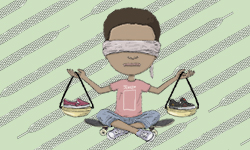 WHAT WOULD MAKE SKATERS DITCH THE BIG SHOE BRANDS?
WHAT WOULD MAKE SKATERS DITCH THE BIG SHOE BRANDS?
We asked younger skaters how small shoe brands could win back their business from the big budget behemoths.
-
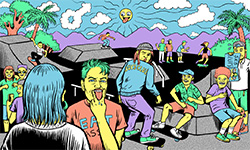 MY EXPERIENCES IN SKATEBOARDING
MY EXPERIENCES IN SKATEBOARDING
"I've been terrified of garnering the reputation of 'ramp-tramp' or 'pro-ho' just from spending time with skaters."
-
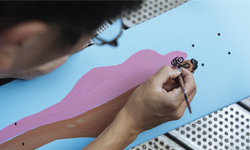 MEET UNITY, SKATEBOARDING’S MOST PROGRESSIVE CREW
MEET UNITY, SKATEBOARDING’S MOST PROGRESSIVE CREW
"Never has my gay life intersected with my skateboarding life. If anything, maybe I’d worked to pull them apart."
-
 HOW CAN WE HELP KEEP SKATE SHOPS ALIVE?
HOW CAN WE HELP KEEP SKATE SHOPS ALIVE?
For years brands and skaters have blindly cried "support your local," but we asked shop owners about other ways we can all provide actual help.
-
 WHAT HAPPENED TO GERSHON MOSLEY?
WHAT HAPPENED TO GERSHON MOSLEY?
From punching Andrew Reynolds, to not getting "pimped" by the industry, Gershon covers everything you wanted to know.

July 29, 2020 5:06 pm
8.25 goes with independents 144, 139 are for 8 inch board.
i would even prefere 149 on a 8.25 actually, so nope to the 139 on it
July 29, 2020 5:07 pm
8.25 goes with independents 144, 139 are for 8 inch board.
i would even prefere 149 on a 8.25 actually, so nope to the 139 on it
August 6, 2020 3:31 am
Awesome article! Ive been running riser pads for a while and a lot of my homies are getting into them. That is maybe the only thing missing from this list. They’re awesome for preventing wheel bite, getting more height on ollies (according to Professor Schmitt) and I believe that soft pads make breaking boards more difficult.
August 9, 2020 6:20 am
Awesome article son!
Depending on what type of wheel you use, you may consider changing the size of your trucks as well. For example, if you decide to skate Hawgs Chubby wheels on an 8.5 board for a commute, you might find a good setup going to Venture 5.25 or Independent 139 trucks. No hard rules.
Personally I skate 78a 52mm wheels on Indy 144s on a 8.5 board with 88a soft bushings
Don’t think we went into bushings as well in this article…maybe that’s the next article!